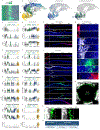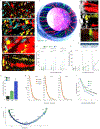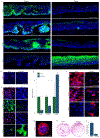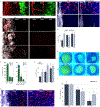Discrete limbal epithelial stem cell populations mediate corneal homeostasis and wound healing
- PMID: 33984282
- PMCID: PMC8254798
- DOI: 10.1016/j.stem.2021.04.003
Discrete limbal epithelial stem cell populations mediate corneal homeostasis and wound healing
Abstract
The accessibility and transparency of the cornea permit robust stem cell labeling and in vivo cell fate mapping. Limbal epithelial stem cells (LSCs) that renew the cornea are traditionally viewed as rare, slow-cycling cells that follow deterministic rules dictating their self-renewal or differentiation. Here, we combined single-cell RNA sequencing and advanced quantitative lineage tracing for in-depth analysis of the murine limbal epithelium. These analysis revealed the co-existence of two LSC populations localized in separate and well-defined sub-compartments, termed the "outer" and "inner" limbus. The primitive population of quiescent outer LSCs participates in wound healing and boundary formation, and these cells are regulated by T cells, which serve as a niche. In contrast, the inner peri-corneal limbus hosts active LSCs that maintain corneal epithelial homeostasis. Quantitative analyses suggest that LSC populations are abundant, following stochastic rules and neutral drift dynamics. Together these results demonstrate that discrete LSC populations mediate corneal homeostasis and regeneration.
Keywords: cornea; immune cells; limbal stem cells; limbus; lineage tracing; mathematical modeling; niche; single cell RNA sequencing; stem cell dynamics.
Copyright © 2021 Elsevier Inc. All rights reserved.
Conflict of interest statement
Declaration of interests The authors declare no competing interests.
Figures





Comment in
-
"Eyeing" corneal stem cell identity, dynamics, and compartmentalization.Cell Stem Cell. 2021 Jul 1;28(7):1181-1183. doi: 10.1016/j.stem.2021.06.001. Cell Stem Cell. 2021. PMID: 34214435
References
-
- Amitai-Lange A, Altshuler A, Bubley J, Dbayat N, Tiosano B, and Shalom-Feuerstein R (2015a). Lineage tracing of stem and progenitor cells of the murine corneal epithelium. Stem Cells 33,230–239. - PubMed
-
- Brandner JM, Kief S, Grund C, Rendl M, Houdek P, Kuhn C, Tschachler E, Franke WW, and Moll I (2002). Organization and formation of the tight junction system in human epidermis and cultured keratinocytes. Eur. J. Cell Biol. 81,253–263. - PubMed
Publication types
MeSH terms
Grants and funding
LinkOut - more resources
Full Text Sources
Other Literature Sources
Medical
Molecular Biology Databases

